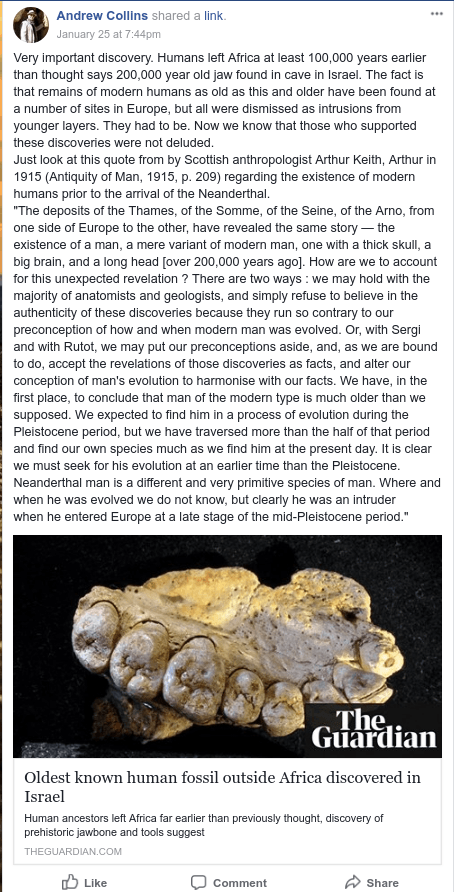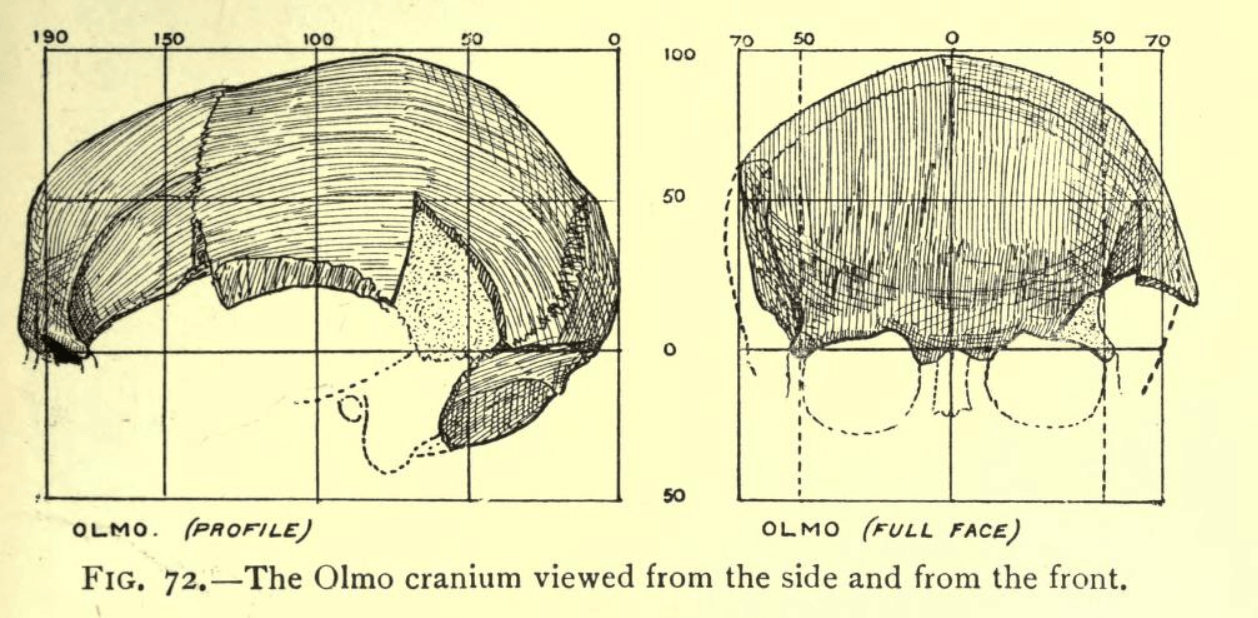

Pseudoarchaeology proponent Andrew Collins posted on Jan. 25 to the aptly named “Megalithomania” Facebook group in response to the “Oldest known human fossil outside Africa” which has garnered much media attention. The mystery-mongers and purveyors of woo are scrambling to see how they can fit this in with their various narratives of fantastic, fraudulent, and fake archaeology. Already, I’ve seen several attempts to weave this into pseudoscientific explanations that put human evolution outside of Africa.
And that is certainly not what this recent find is saying. In fact, it really isn’t saying much that wasn’t already postulated by many paleoanthropologists already, which is that modern humans migrated out of Africa very early. Now there is evidence that shows what was already being assumed by many. I expect that we’ll find yet earlier examples in the future.
But back to Andrew Collins. This is one of those megalithomaniacs that sees undue significance in monumental architecture all over the world. Among his favorite archaeological sites to misrepresent with pseudoscientific assumptions is Gobekli Tepe, so you’ve probably seen his “work” show up in crackpot television shows and YouTube videos. I think he might have a few self-published books on various pseudoarchaeological topics available as well.
In his recent post to the Megalithomania group, Collins opens with: “Humans left Africa at least 100,000 years earlier than thought says 200,000 year old jaw found in cave in Israel. The fact is that remains of modern humans as old as this and older have been found at a number of sites in Europe, but all were dismissed as intrusions from younger layers. They had to be. Now we know that those who supported these discoveries were not deluded.”
Then he leaves the reader with a very long quote by Arthur Keith from 1915. If there’s one thing you can count on from the woo crowd, it’s that they’ll quote or cite something from over a hundred years ago. You know, back before things like fluorine analysis, radiocarbon dating, and extensive databases of geologic strata and human cranial features existed.
Collins erroneously states that remains of humans this age or older have already been found in European sites. And this is just not true.
It is true, however, that in the late 19th century and early 20th century, there were some questions about several remains. There were some suggestions that some remains, such as the Olmo skull that Arthur Keith was referring to in the passage Collins quoted, could show a lineage of modern humans in pre-Mousterian times in Europe. What Collins won’t say is that modern scientific analyses and better understandings of geologic strata led researchers in the 20th century to arrive at better conclusions.
Using the same scientific methods that allowed researchers to hone in and find that nearly 200,000 year old jaw bone in Israel, problems presented by specimens like the Olmo skull (which is really just a skull cap; the maxilla, mandible, and other cranial bones are missing) could be resolved. And the problems of that specimen didn’t include what Collins would have his followers believe. It seems he’d like people to believe that some mysterious establishment sought to oppress a “truth” about such specimens. He writes in his post quoted above, “they had to be,” implying that dismissal by this mystery establishment was an imperative.
But by whom?
There is no Cabal of archaeology. There is no central authority. In fact, trying to get archaeologists and anthropologists to agree on any single thing not related to a happy hour is like herding cats. And every one of them would like to be remembered for something. So, you can bet your last nickel for a dime, if one of them had evidence that pushes a date back, a paper would be written and a book published. In fact, that’s happened several times! The recent news of the 200,000 year old human jaw in Israel is evidence of it.
Collins thinks that this find vindicates the pseudoscientific claim that modern humans have been in Europe for 200,000+ years. That would be seriously fallacious (a false equivocation) thinking on his part because a find in Israel (a few days walk from Africa) doesn’t equate to modern humans in Italy or France. It doesn’t mean there weren’t. It just doesn’t mean there were. A nearly 200 kya jawbone in Israel is evidence that modern humans (at least one) made it to that spot and died at that time. It does, however, increase the probability that we’ll find older remains of modern humans in Europe.
So what’s the deal with the Olmo skull?
The guy that found it continued his research. Sure, he initially said he thought the find was in a stratum that placed the date to a pre-Mousterian age. But Ignio Cocchi, after continued study, revised his assessment, placing the specimen in a stratum at the end of the Quaternary. In the Pleistocene to be exact. And the British Museum conducted fluorine analysis of the bone and found that the matrix the specimen was found in to be consistent with gravel. This would put it in a Pleistocene layer.

There were definitely problems with specimens like the Olmo skull. But the problems aren’t those imagined by Collins and his ilk, who erect these large opponents who look fierce but are, in reality, stuffed with the straw of fake, fraudulent, and fantastic science. The problem that genuine researchers had with specimens like Olmo were that it was an outlier. It’s presence created a multitude of additional questions when no other supporting data are found with it. Such things happen in science, to be sure, but they are necessarily shelved until they can at least potentially be falsified. Or supported with additional data. That’s how science works. When additional data do the opposite, we have to accept the conclusion. Until such time as new data arrive.
This is what folks like Collins have a problem with. The reason, I would surmise, is that they begin with a conclusion. They have a view of how the world should be. From there, it’s all about fitting data into that model rather than the other way around.
Hint: science begins with data first.
Further Reading
MacCurdy, G. G. (1942). Human Origins: A Manual of Prehistory. Vol. 1. Appleton and Co, p. 412
Oakley,Kenneth; Molleson, Theya; Cambell, Bernard (1971). Catalog of Fossil Hominids. British Museum, p. 248
I don’t get why earlier migrations out of Africa make such a great difference – it doesn’t change the ages of Gobeli or Stonhenge or anything else.
I think part of the narrative many of these guys want to promote is that there were civilizations with technology comparable to exceeding those of today at some point in deep time.